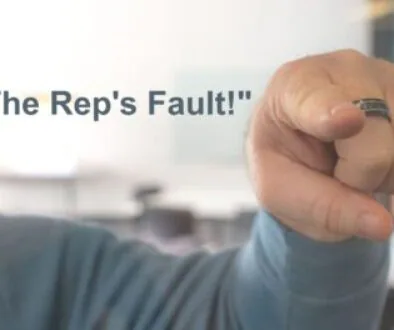Medical Sales Decision-Making: Crash and Burn or Go-Around?

Last week as I began my day in the office preparing for a keynote presentation, the cloudless blue sky beckoned me to take my airplane (Sales Pilot, remember?) for a short ride. I launched on a quick flight to get some breakfast at an airport café about 20 minutes away. Flying conditions were perfect with silky smooth air and not even the slightest hint of wind.
When I was ten minutes out from my home airport on the return flight, I tuned in a radio frequency to check wind speed and direction. Conditions had changed dramatically from what they were on departure. The wind was now 19 gusting to 27 miles per hour and it was a crosswind (blowing perpendicular to the runway) to boot.
In my airplane, 19 miles per hour is at the limits of the airplane’s crosswind capabilities as well as my own. I overflew the runway to confirm the wind direction with the windsock and chose the north end, runway 16, for my intended landing. All indications were that I would be dealing with a direct crosswind from the left as I touched down.
I turned final approach and during the descent, something just didn’t feel right. I wasn’t going to touch down on the numbers painted on the runway like I always do. It soon became apparent that I was landing with a strong tailwind and would not have enough runway left to stop if I tried to get it on the ground. I executed a Go-Around, the name given to aborting a landing and climbing back up to a safe altitude.
Passing the windsock on the opposite end of the runway confirmed that I was dealing with a direct and very strong tailwind. Turning a difficult landing into an easy one seemed as simple as landing in the opposite direction from the one I just attempted.
Everything felt perfect as I flew the final approach to Runway 34. The airplane was bucking in the strong and gusty headwind, but I was aligned with the runway. As I was about to touch down, the wind suddenly shifted to a direct crosswind from the right. I applied full rudder to align the airplane with the runway, but I had “more wind than rudder.” The airplane was tracking sideways down the runway, which is a very bad way to land; it could result in a collapsed landing gear or going off the side of the runway into a ditch. Again, The Go-Around was the better option and I climbed back into the air for another trip in the landing pattern. I hoped none of my pilot-friends were watching!
I circled around for another landing attempt on Runway 34, only this time anticipating a sudden change in wind direction and I was prepared to go-around. The third time was a charm as the wind cooperated and allowed me to complete a very satisfying cross-wind landing. This time I hope my pilot-friends were watching!
What does my story have to do with sales? Everything!
Flying is a wonderful, but very unforgiving activity. It seems like 99% of the time, things go exactly as you expect, but when conditions change with anything…the airplane, the weather, or even the pilot…things can go wrong in a hurry. When the price for facing unexpected change is great, failing to anticipate change is a dangerous form of complacency. The same thing is true in healthcare sales.
Selling in healthcare (and other rapidly changing industries) means that you’re always facing the risk of unanticipated change. Too often, sales reps stick with the original plan in the face of change because they don’t know how to react or what their options are when new conditions are suddenly encountered. They could be risking a crash-and-burn situation with their customers that can have lasting effects but they don’t take the time to consider it.
Your first best option when you’re trying to land (either an airplane or a sale) and conditions suddenly change is… The Go-Around.
In flying, the go-around is a procedure to abort the landing. It transitions the airplane from a potentially dangerous situation—low, slow and close to the ground without a safe landing assured—to a controlled climb that takes you away from immovable objects (the ground, trees, etc.!) and back up to a safe altitude. Now you can assess your options while avoiding or minimizing risk.
Medical sales reps frequently find themselves facing situations they don’t expect, such as when trying to close a deal and the customer changes buying criteria without warning. Sure, you can stick to your original plan and hope it all works out, but you could also come off as a bad solution and careless. It’s safer to execute The Go-Around and re-assess your options. This might mean that you ask for more time, even just a few minutes, to reconsider how you might be able to move forward in light of new information or expectations.
You sell in an ever-changing sales environment. Expect change and be spring-loaded to react to it. When a predictable conclusion is not assured, don’t risk a bad outcome that could take you out of the game forever. Instead, Go-Around! It’s the safe thing to do and just as I did, you’ll achieve great satisfaction in the smooth landing that will eventually follow.



@ 3:01 pm
Did you ever force the original plan and wish you didn’t? Please share your story here….